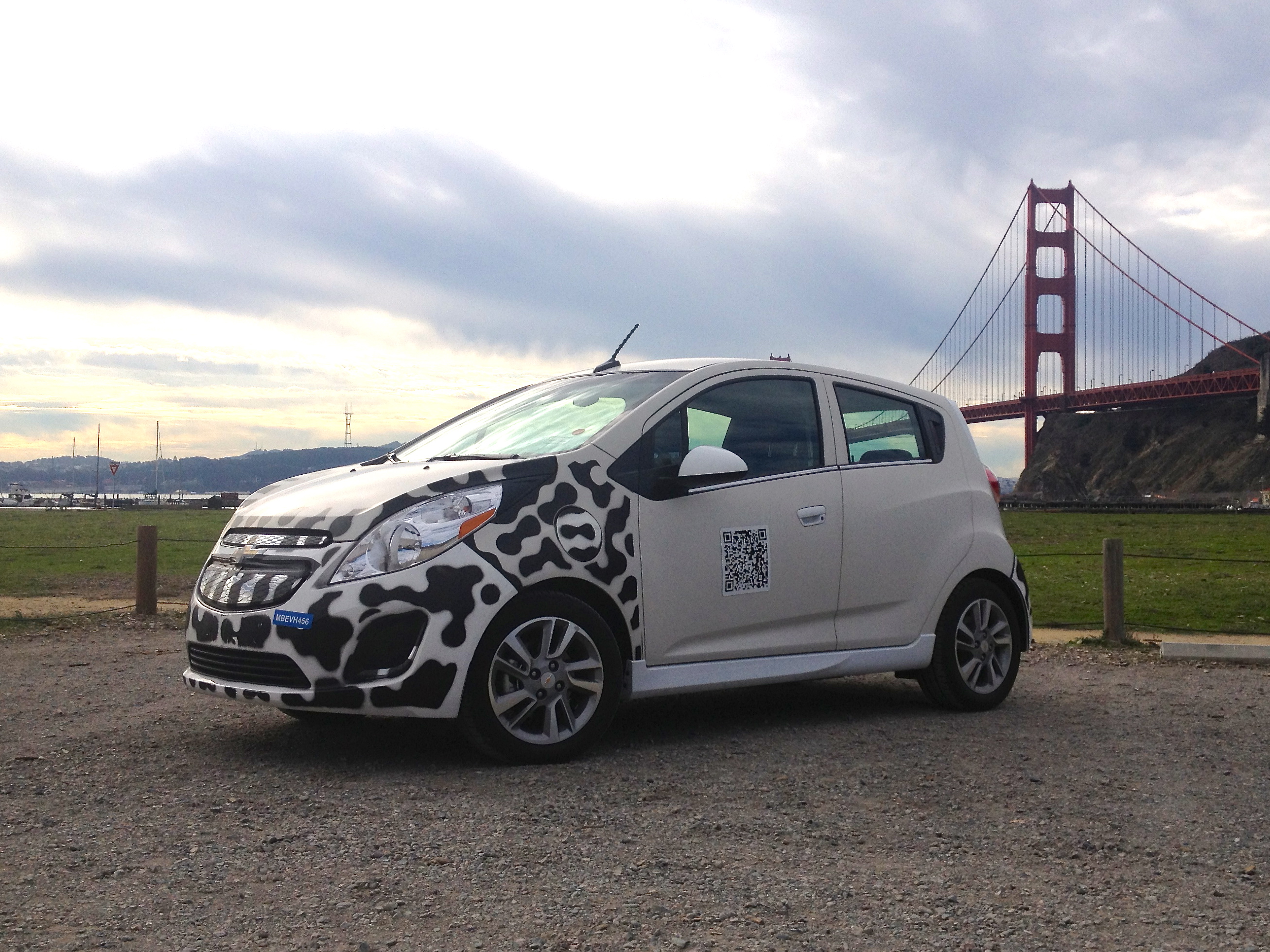Preview: 2014 Chevrolet Spark Electric Vehicle
Story and photos by John LeBlanc
SAUSALITO, Calif. — Toyota has become synonymous for them. Ford is launching a bunch of them. And Honda is working on getting some. No, I’m not talking about product recalls. I’m speaking of gasoline-electric hybrid vehicles — the best known of which is Toyota’s iconic Prius.
The marriage of gasoline-fired internal combustion engines and electric motors have become a convenient way for automakers to meet ever-tightening government fuel economy standards without drastically reducing customers’ desire for performance. They don’t inflict “range anxiety” like pure electric vehicles and, more importantly, work within the existing (and foreseeable future) global refueling infrastructure.
No doubt, the electrification of the automobile — whether it’s in the form of “mild” hybrids (with their stop/start systems), full hybrids (like the Prius, that recharge themselves), plug-in hybrids (like the Chevrolet Volt, that add a bit more electric-only driving) or pure electric vehicles (like the Nissan Leaf) — has proven to be a quick fix for the auto industry. And within the growing e-car portfolio, the industry sees traditional, full hybrids continuing to make up the vast majority of electrified vehicle sales. For example, Toyota has admitted that current battery technology and expensive production costs mean pure electric cars are a virtual dead end once government incentives go away, while Ford sees about 70% of its electrified fleet being full-hybrids that don’t require to be plugged in.
But not General Motors.
Unlike most of its rivals, GM has never really embraced full hybrids. Its current “mild hybrid” eAssist models aren’t competitive with full hybrids such as the Ford Fusion, Toyota Camry or Hyundai Sonata/Kia Optima sedans. And GM’s only full hybrid, its full-size pickups and SUVs, have been sales flops, and won’t be replaced when all-new versions arrive next year. Perhaps because of its lack of success with mainstream hybrids, GM is chasing the remaining 25% of the e-car market, betting heavily not on traditional full hybrids but plug-in hybrids and pure electric vehicles.
“A major focus for GM’s electrification strategy will centre on the plug,” the U.S. automaker’s product chief, Mary Barra, said via a video conference call during a preview of the forthcoming 2014 Chevrolet Spark Electric Vehicle — GM’ s first pure electric car since the well-documented 1996 to 1999 EV1.
Introduced just this year, the gas-engine Spark is the smallest car Chevy offers, smaller than its subcompact Sonic sibling. And unlike city car rivals such as the Fiat 500, Scion iQ and Smart ForTwo, the front-wheel-drive Spark hatchback has four doors. Starting at $13,495, the Spark is cheap to buy. And with its 1.2-litre four-cylinder gas engine, rated at 84 horsepower and 83 pound-feet of torque, it’s also cheap to run. Transport Canada rates it at 7.1 L/100 km in the city and 5.2 on the highway.
But for a few customers (and some governments — hello, California!), the Spark is a gas hog, a dirty little car that can only be fixed by eliminating those noxious, dino-juice-derived tailpipe emissions. Hence the electric Spark (no puns, please), set to go on sale next year.
As per the norm, the Spark EV weighs more than the gas version. But that doesn’t make it slower. Chevrolet says the Spark EV “will set a benchmark in performance for an urban city electric vehicle.” My two laps piloting a pre-production model around our hotel grounds wasn’t enough seat time to either agree or disagree with that boast. But one look at its spec sheet suggests the Spark EV may end up as the Corvette of electric city cars.
With a 100 kw-H electric motor making 130 hp and a whopping 400 lb-ft, not only does the Spark EV blow away its gas counterpart, it makes rivals like the Smart Electric Drive (40 hp and 88.5 lb-ft) and Mitsubishi i-MiEV (66 hp and 145 lb-ft) look like golf carts. Using a single-gear automatic transmission, Chevy says the Spark EV can scoot from zero to 96 kilometres an hour in “under eight” seconds. This means you could have a sip or three of your latte waiting for the gas Spark (13.5 seconds), Smart ED (14 seconds) and the i-MiEV (14.5) to catch you entering a highway.
We’ll have to wait until its debut at next week’s Los Angeles auto show to find out how far you’ll be able to race around in your Spark EV before you’ll need to plug it in. The engineers on hand said the Spark EV would be competitive with rivals (the Smart ED has a 135-kilometre range and the Mitsubishi EV gets 100 km).
GM doesn’t have pricing yet, either. But it does say it will “competitive” with the $26,990 Smart and $32,998 Mitsubishi EVs. That said, the market for twice-as-expensive electric versions of city cars is pretty small. Mercedes-Benz Canada expects to sell hundreds, not thousands, of its Smart Electric Drive on an annual basis.
Apparently, when it comes to the electrification of the car, GM seems happy being a big fish in a small pond.






![[del.icio.us]](https://www.straight-six.com/wp-content/plugins/bookmarkify/delicious.png)
![[Digg]](https://www.straight-six.com/wp-content/plugins/bookmarkify/digg.png)
![[Facebook]](https://www.straight-six.com/wp-content/plugins/bookmarkify/facebook.png)
![[Google]](https://www.straight-six.com/wp-content/plugins/bookmarkify/google.png)
![[Reddit]](https://www.straight-six.com/wp-content/plugins/bookmarkify/reddit.png)
![[StumbleUpon]](https://www.straight-six.com/wp-content/plugins/bookmarkify/stumbleupon.png)
![[Twitter]](https://www.straight-six.com/wp-content/plugins/bookmarkify/twitter.png)
![[Email]](https://www.straight-six.com/wp-content/plugins/bookmarkify/email.png)